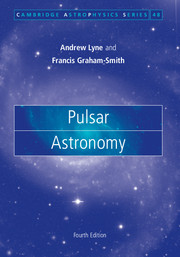Book contents
- Frontmatter
- Contents
- List of illustrations
- Preface
- 1 The discovery of pulsars
- 2 Neutron stars
- 3 Telescopes and techniques
- 4 The distances of the pulsars
- 5 Pulsar timing
- 6 Timing and astrometry of binary pulsars
- 7 Timing irregularities
- 8 The Galactic population of pulsars
- 9 The Crab and Vela Pulsars
- 10 Other young pulsars
- 11 Millisecond and binary pulsars
- 12 Accretion-powered X-ray pulsars
- 13 Magnetars
- 14 Supernovae and their remnants
- 15 Integrated pulse profiles
- 16 Individual pulses
- 17 Location of emitting regions
- 18 Radiation processes
- 19 The emission mechanisms
- 20 Interstellar scintillation and scattering
- 21 The interstellar magnetic field
- 22 Achievements and prospects
- References
- Index
9 The Crab and Vela Pulsars
Published online by Cambridge University Press: 05 March 2012
- Frontmatter
- Contents
- List of illustrations
- Preface
- 1 The discovery of pulsars
- 2 Neutron stars
- 3 Telescopes and techniques
- 4 The distances of the pulsars
- 5 Pulsar timing
- 6 Timing and astrometry of binary pulsars
- 7 Timing irregularities
- 8 The Galactic population of pulsars
- 9 The Crab and Vela Pulsars
- 10 Other young pulsars
- 11 Millisecond and binary pulsars
- 12 Accretion-powered X-ray pulsars
- 13 Magnetars
- 14 Supernovae and their remnants
- 15 Integrated pulse profiles
- 16 Individual pulses
- 17 Location of emitting regions
- 18 Radiation processes
- 19 The emission mechanisms
- 20 Interstellar scintillation and scattering
- 21 The interstellar magnetic field
- 22 Achievements and prospects
- References
- Index
Summary
Young pulsars
Although it is now accepted that most neutron stars are born in supernova explosions, only a small number of the known pulsars are clearly associated with visible supernova remnants (SNRs) (see Figure 8.7). This is, of course, entirely consistent with the difference between the lifetimes of a typical pulsar (about 106–107 years) and a supernova remnant (about 104–105 years). Furthermore, most of these associated pulsars are obviously young, as seen from their large period derivatives Ṗ. Most have short periods, with P < 100 ms. Their small characteristic ages, P/2Ṗ, are in sharp contrast with those of the other short-period pulsars, the millisecond pulsars (Chapter 10), which have very small period derivatives, are much older, and are the product of a long evolutionary history.
In this chapter we concentrate on two of the youngest, the Crab Pulsar and the Vela Pulsar, both of which are associated with SNRs and both of which have been studied in great detail. These young pulsars are to be found in the top left of the P–Ṗ diagram (Figure 8.7), and their progress across this diagram is expected to bring them into the upper part of the general population within 106 years. Their youthful characteristic of a large power output makes them easy to observe. Both are detected as radio, optical, X-ray and gamma-ray sources, and the evolution of their rotation rate has been monitored in detail for over 40 years.
- Type
- Chapter
- Information
- Pulsar Astronomy , pp. 117 - 133Publisher: Cambridge University PressPrint publication year: 2012

